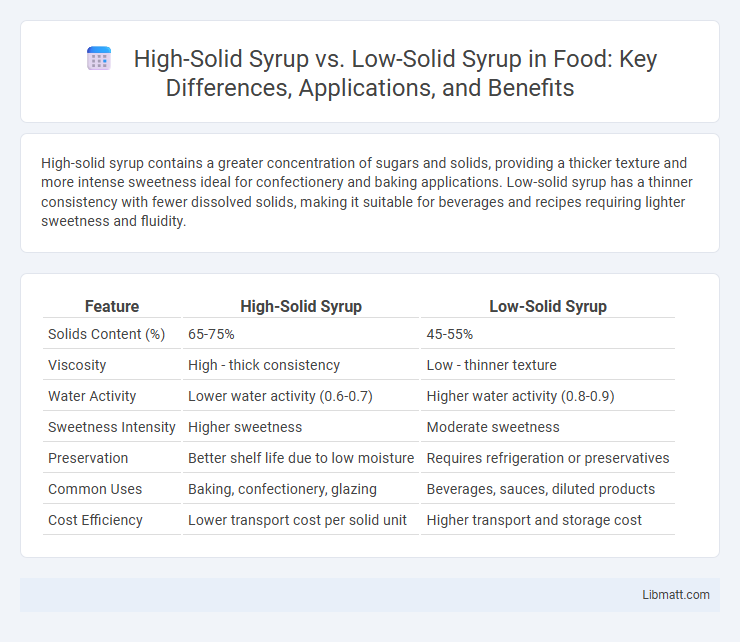High-solid syrup contains a greater concentration of sugars and solids, providing a thicker texture and more intense sweetness ideal for confectionery and baking applications. Low-solid syrup has a thinner consistency with fewer dissolved solids, making it suitable for beverages and recipes requiring lighter sweetness and fluidity.
Table of Comparison
| Feature | High-Solid Syrup | Low-Solid Syrup |
|---|---|---|
| Solids Content (%) | 65-75% | 45-55% |
| Viscosity | High - thick consistency | Low - thinner texture |
| Water Activity | Lower water activity (0.6-0.7) | Higher water activity (0.8-0.9) |
| Sweetness Intensity | Higher sweetness | Moderate sweetness |
| Preservation | Better shelf life due to low moisture | Requires refrigeration or preservatives |
| Common Uses | Baking, confectionery, glazing | Beverages, sauces, diluted products |
| Cost Efficiency | Lower transport cost per solid unit | Higher transport and storage cost |
Introduction to High-Solid and Low-Solid Syrup
High-solid syrup contains a higher concentration of dissolved sugars, typically above 70%, resulting in thicker viscosity and longer shelf life compared to low-solid syrup, which usually has less than 60% solids and a more fluid consistency. Your choice between high-solid and low-solid syrup impacts sweetness intensity, texture, and stability in food and beverage applications. Understanding the solid content helps optimize product formulation for desired taste, mouthfeel, and preservation qualities.
Defining Solids Content in Syrups
Solids content in syrups refers to the concentration of dissolved sugars and other solid ingredients, measured as a percentage by weight. High-solid syrup typically contains over 70% solids, resulting in greater viscosity and sweetness, while low-solid syrup has less than 60% solids, offering a thinner texture and milder flavor. Understanding solids content helps you select the right syrup consistency for your culinary or industrial applications.
Production Process Differences
High-solid syrup production involves concentrating sugars to higher total solids content, typically above 70%, through extended evaporation or vacuum concentration techniques that reduce water activity and increase viscosity. Low-solid syrup is produced with less concentration, maintaining total solids around 45-60%, resulting in thinner consistency and shorter evaporation times. These differences in the production process affect syrup stability, shelf life, and applicability across various food and beverage products, which can influence Your choice depending on the desired final product characteristics.
Physical Properties: Viscosity and Texture
High-solid syrup exhibits significantly higher viscosity due to its increased concentration of dissolved solids, resulting in a thicker and more cohesive texture compared to low-solid syrup. The reduced water content in high-solid syrup enhances its resistance to flow and provides a denser mouthfeel, making it ideal for applications requiring structural integrity. In contrast, low-solid syrup has a thinner consistency with lower viscosity, offering a lighter texture suitable for beverages or as a sweetening agent where fluidity is essential.
Sweetness and Flavor Impact
High-solid syrup contains a greater concentration of dissolved sugars, resulting in enhanced sweetness and a more intense flavor profile compared to low-solid syrup. Low-solid syrup offers a milder sweetness, which preserves delicate flavors without overwhelming your recipe. Choosing between these syrups depends on the desired balance between sweetness and flavor impact in your culinary or beverage creation.
Shelf Life and Preservation
High-solid syrups, containing higher sugar concentrations, inhibit microbial growth more effectively, resulting in extended shelf life compared to low-solid syrups. Low-solid syrups, with higher moisture content, are more susceptible to fermentation and spoilage, requiring preservatives or refrigeration for preservation. Optimal storage conditions and packaging also influence the stability and shelf life of both syrup types.
Industrial and Culinary Applications
High-solid syrup, containing over 70% solids, offers concentrated sweetness and reduced moisture, making it ideal for industrial applications like confectionery, baking, and beverage production where shelf stability and texture consistency are critical. Low-solid syrup, with less than 70% solids, provides easier blending and hydration, preferred in culinary uses such as sauces and dressings that require more fluidity and less intense sweetness. Your choice between high-solid and low-solid syrup impacts product quality, processing efficiency, and final flavor profiles in various food manufacturing and culinary settings.
Cost and Efficiency Comparison
High-solid syrup offers greater cost efficiency due to its concentrated sugar content, reducing transportation and storage expenses compared to low-solid syrup. Low-solid syrup requires larger volumes to achieve the same sweetness, leading to higher packaging and handling costs. Processing high-solid syrup enhances production efficiency by minimizing water usage and energy consumption during manufacturing.
Nutritional Implications
High-solid syrup contains a greater concentration of sugars and calories per serving compared to low-solid syrup, affecting your overall energy intake and blood sugar levels. Choosing low-solid syrup can help reduce calorie consumption and minimize rapid glycemic spikes, supporting better metabolic health. Nutritional implications are crucial for dietary planning, especially for individuals managing weight or diabetes.
Choosing the Right Syrup for Your Needs
High-solid syrup contains a higher percentage of dissolved solids, offering a thicker consistency and more intense sweetness, ideal for bakery applications and confectioneries requiring moisture retention. Low-solid syrup has a thinner texture with fewer dissolved solids, making it suitable for beverages and recipes needing quick dilution or lower calorie content. Selecting the right syrup depends on the desired viscosity, sweetness level, and application requirements to achieve optimal texture and flavor balance.
high-solid syrup vs low-solid syrup Infographic

 libmatt.com
libmatt.com